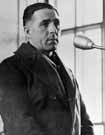
|
|
|

|

|

|

|
|
Click on an image to see a larger, more detailed picture.
|
|
|
|
|
| EPILOGUE: The Aftermath |

|
pg. 680 |

|
|
|
|
| |
 Fifty years after the fact, the Nazis' gross criminality caused ill feelings between Catholics and Jews. Seen here in a 1947 trial photo is one of the wartime criminals, Auschwitz guard Vladimir Bilan.
Fifty years after the fact, the Nazis' gross criminality caused ill feelings between Catholics and Jews. Seen here in a 1947 trial photo is one of the wartime criminals, Auschwitz guard Vladimir Bilan.
Photo: State Museum of Auschwitz-Birkenau / United States Holocaust Memorial Museum Photo Archive
|
 Post-Holocaust controversies aside, it is clear that the killers, such as Auschwitz commandant Rudolf Höss, were people of no real character or stature.
Post-Holocaust controversies aside, it is clear that the killers, such as Auschwitz commandant Rudolf Höss, were people of no real character or stature.
Photo: Yad Vashem
|
|
Switon's work at the site included something else. He booby-trapped the "chapel" with plastic explosives to prevent the demolition that local authorities had ordered. As police cleared the crosses--the large, 26-foot one was left standing--they also detained Switon and carefully detonated the explosives. Among those relieved by the defusing of the situation were many Roman Catholic leaders in Poland, who feared that the controversy at Auschwitz would sour Pope John Paul II's visit to his Polish homeland. That visit, which began less than ten days later on June 5, included the beatification of 108 Polish Catholics who were murdered--some of them at Auschwitz--by the Nazis during World War II. Among the 108 were nuns and priests who helped rescue Jews during the Holocaust. Will the removal of the crosses and the disarming of Switon's explosives be the last episode in Christian-Jewish conflict about Auschwitz? That is far from clear and even unlikely. A case in point involves a building at Auschwitz-Birkenau. Just outside the barbed-wire perimeter, situated across a narrow road, there is a former Nazi facility that is clearly identified on Auschwitz-Birkenau maps as the "new commandant's office." This structure was transformed into a Catholic church early in the 1980s. Among other functions, it commemorates Edith Stein, a German Jew who converted to Catholicism in 1922, became a nun as well as a distinguished philosopher, and was deported in 1942 from the Netherlands to Birkenau, where she was gassed. Although her deportation was provoked by Dutch Catholic dissent against Nazi antisemitism, Stein was not murdered primarily because she was Catholic but because, according to the Nazis' racial definitions, she was Jewish. The Vatican's 1998 decision to canonize her as a saint was greeted with considerable disagreement, especially but not exclusively among Jews. Meanwhile, little protest about the Birkenau church took place when its doors first opened, but controversy about it has swirled since, and history suggests that it might do so again. On August 1, 1984, a small group of nuns from the Order of Our Lady of Mount Carmel moved into the Theatergebäude (Old Theater building) at the site of Auschwitz I. The yard of this building would eventually be the place where the large papal cross appeared and the site of the many crosses erected in the summer of 1998.
|
|

|

|

|

|
 March 27, 1984: The United States deports Arthur Rudolph. A Nazi scientist and engineer at Peenemünde, Germany, Rudolph was brought to America as part of "Project Paperclip." His citizenship is revoked after his wartime activities are exposed.
March 27, 1984: The United States deports Arthur Rudolph. A Nazi scientist and engineer at Peenemünde, Germany, Rudolph was brought to America as part of "Project Paperclip." His citizenship is revoked after his wartime activities are exposed.
|
 1985: Shoah, director Claude Lanzmann's 81/2-hour Holocaust documentary film, is released.
1985: Shoah, director Claude Lanzmann's 81/2-hour Holocaust documentary film, is released.
|
 1985: Soviet film director Elem Klimov releases Come and See, a profoundly disturbing drama about Einsatzgruppen activity in Russia in 1943.
1985: Soviet film director Elem Klimov releases Come and See, a profoundly disturbing drama about Einsatzgruppen activity in Russia in 1943.
|
 1985: Revisionist "historian" Ernst Zundel is tried in Toronto, Canada, for publishing an antisemitic pamphlet entitled Did Six Million Really Die? Zundel is found guilty of spreading false information and is sentenced to 15 months in prison.
1985: Revisionist "historian" Ernst Zundel is tried in Toronto, Canada, for publishing an antisemitic pamphlet entitled Did Six Million Really Die? Zundel is found guilty of spreading false information and is sentenced to 15 months in prison.
|
|
|
|
|
| EPILOGUE: The Aftermath |

|
pg. 680 |

|
|
The Holocaust Chronicle
© 2009 Publications International, Ltd.
|
|
